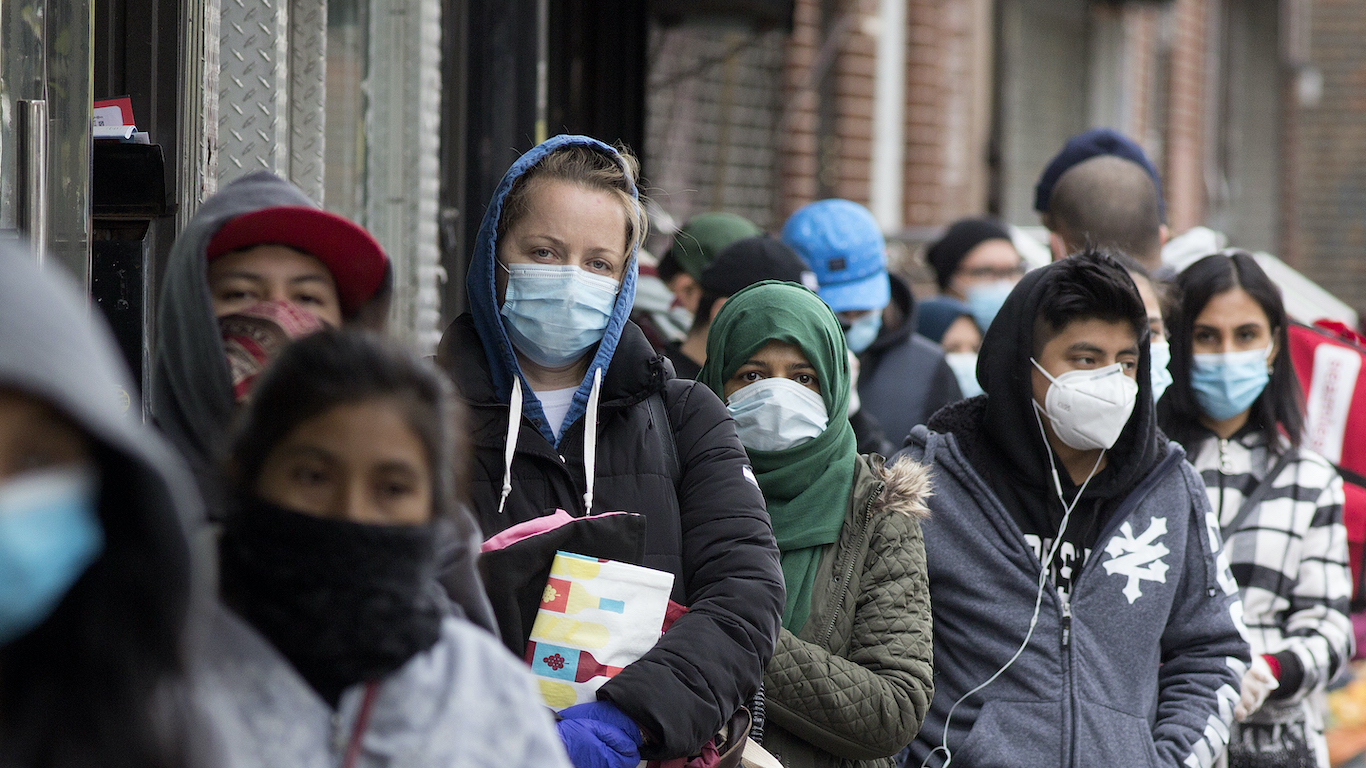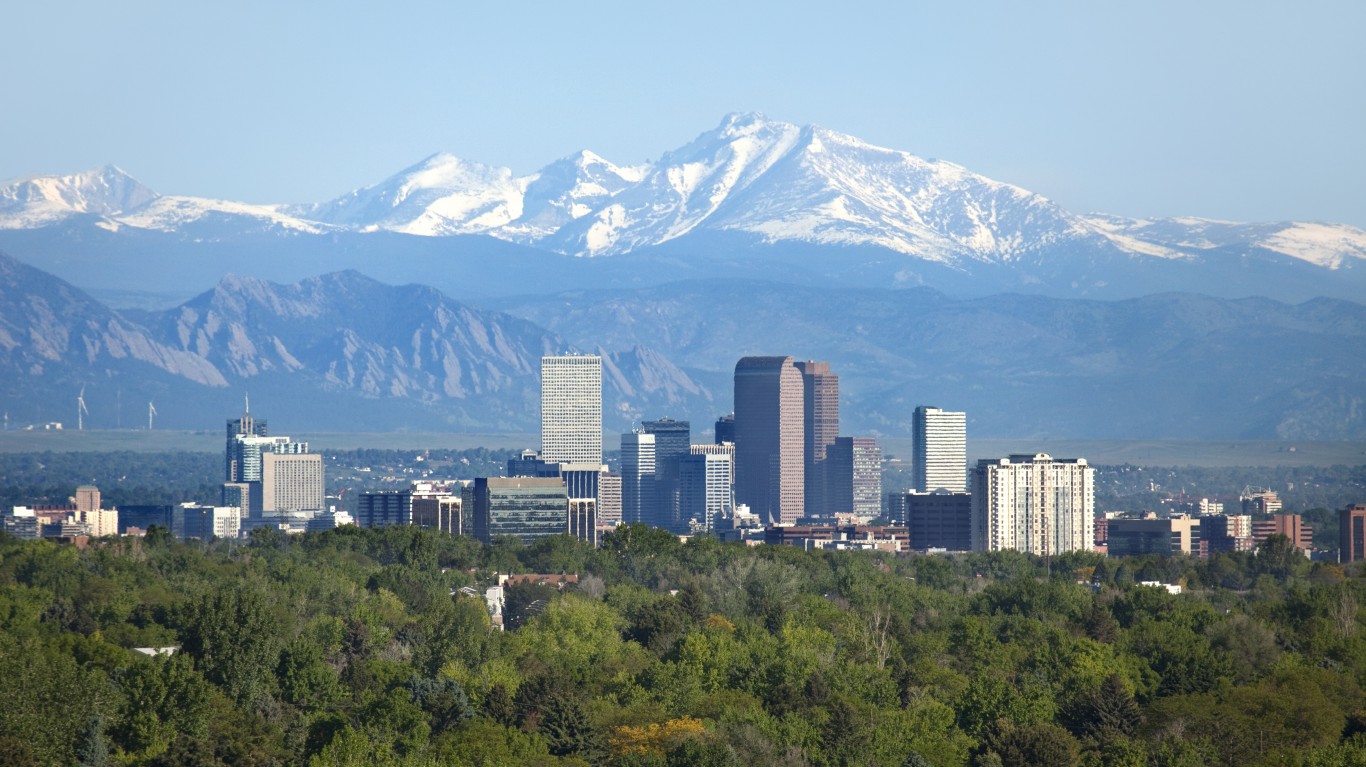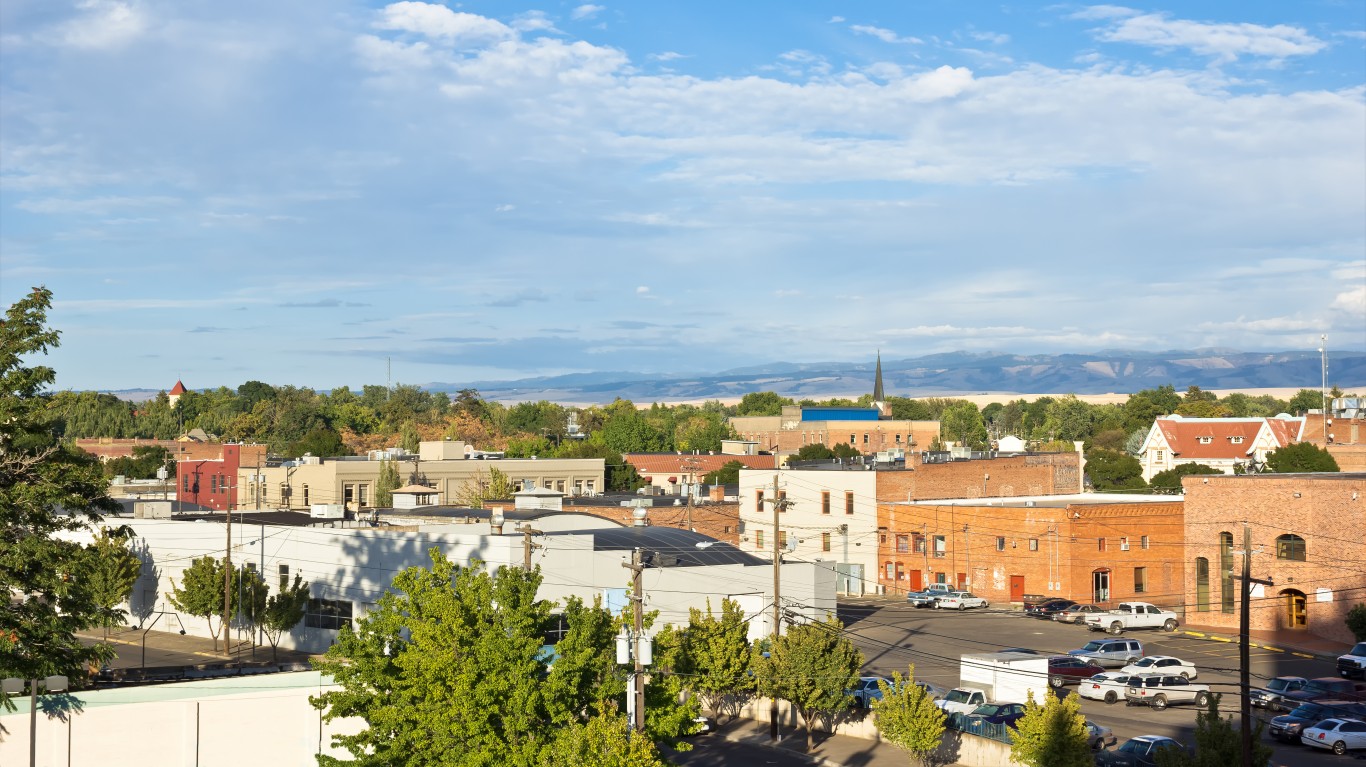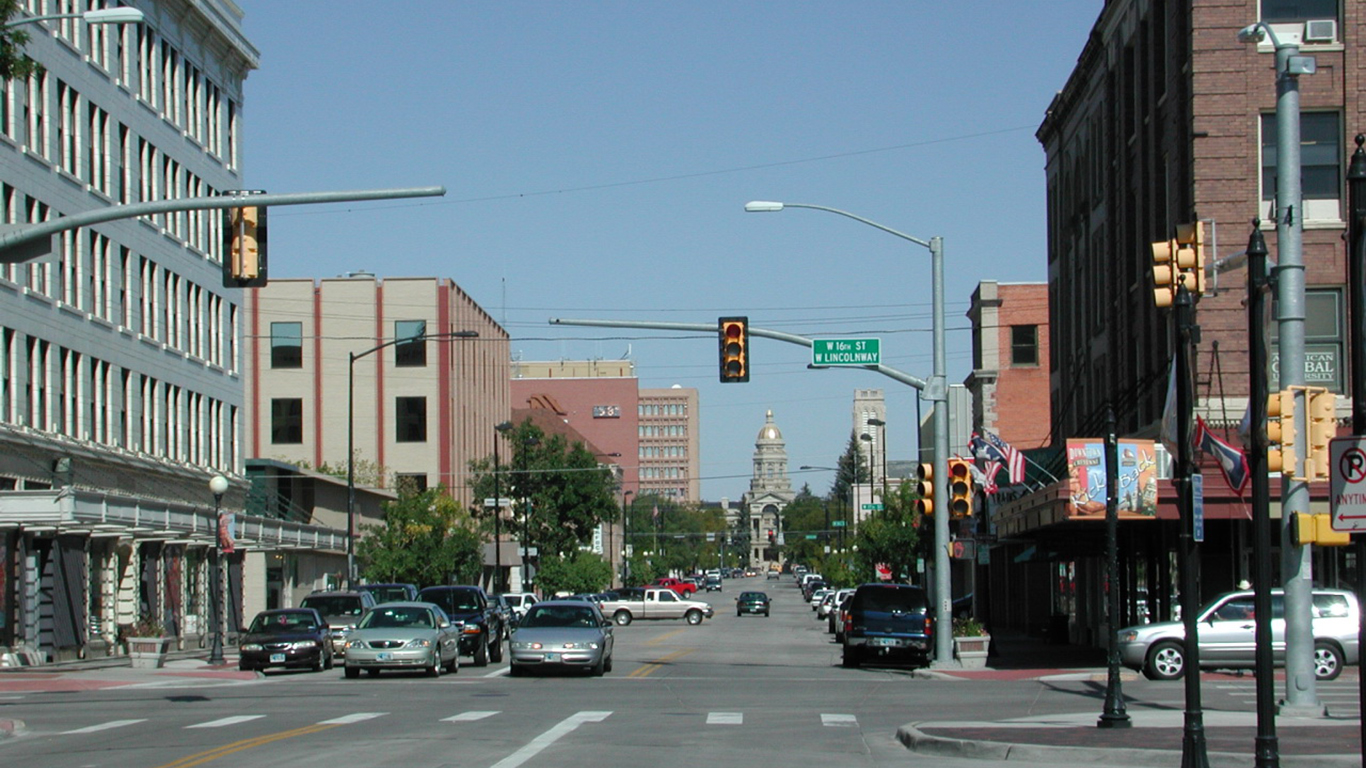Special Report
Every State's Unemployment Claims Since COVID-19 Shut the Economy Down

Published:
Last Updated:

The novel coronavirus has infected nearly 1.4 million people and claimed more than 84,000 lives in the United States alone. The scope of the public health crisis posed by COVID-19 is matched perhaps only by its economic impact. Since President Donald Trump declared a national emergency in mid-March, more than 33 million people have filed unemployment claims.
The staggering number of jobless claims filed every week in the United States has pushed the monthly unemployment rate to 14.7% — a level not seen since the Great Depression. In the latest weekly round of layoffs, another 2.6 million Americans filed for unemployment.
As unemployment claims have continued to surge by the millions with each passing week, 24/7 Wall St. has been compiling a state-by-state review of jobless claims. Job losses by state range from the tens of thousands to the millions over the eight weeks beginning on March 15, amounting to anywhere from 9% to 36% of each state’s total workforce before the pandemic hit.
The current economic downturn is largely attributable to efforts to contain the spread of the virus. Officials across the country have heeded advice from health experts and instituted a range of measures to facilitate social distancing, from shelter-in-place orders to closing nonessential businesses. Many of those states are beginning to partially reopen their economies, or are planning to do so soon. Here’s when every state plans to lift COVID-19 restrictions.
The places where unemployment rates are projected to be the highest in the coming months tend to be those that rely on industries that will likely bear the brunt of the current economic downturn. These industries include leisure and hospitality, travel services, transportation and warehousing, and oil and gas extraction. These industries are the economic backbone of cities across the country. Here is a look at the places a COVID-19 recession will likely hit hardest.
Click here to see every state’s unemployment claims since COVID-19 shut the economy down
Click here to read our methodology

Alabama
> Unemployment claims since mid-March: 471,441 (25th fewest)
> Unemployment claims relative to workforce: 21.0% of workforce (18th highest)
> Most recent week’s unemployment claims (May 3 – May 9): 25,929 (23rd fewest)
> Change in weekly claims from one year ago: +23,525 (+978.6%)
> Pct. of workers in high-risk industries: 16.8% (21st lowest)
> Projected July 2020 unemployment rate: 14.5% (6th lowest)
[in-text-ad]

Alaska
> Unemployment claims since mid-March: 88,643 (5th fewest)
> Unemployment claims relative to workforce: 25.7% of workforce (11th highest)
> Most recent week’s unemployment claims (May 3 – May 9): 8,367 (12th fewest)
> Change in weekly claims from one year ago: +7,596 (+985.2%)
> Pct. of workers in high-risk industries: 21.8% (4th highest)
> Projected July 2020 unemployment rate: 17.8% (3rd highest)

Arizona
> Unemployment claims since mid-March: 548,489 (20th most)
> Unemployment claims relative to workforce: 15.6% of workforce (14th lowest)
> Most recent week’s unemployment claims (May 3 – May 9): 31,795 (23rd most)
> Change in weekly claims from one year ago: +27,531 (+645.7%)
> Pct. of workers in high-risk industries: 19.3% (15th highest)
> Projected July 2020 unemployment rate: 15.4% (24th lowest)

Arkansas
> Unemployment claims since mid-March: 202,517 (16th fewest)
> Unemployment claims relative to workforce: 14.9% of workforce (9th lowest)
> Most recent week’s unemployment claims (May 3 – May 9): 12,416 (17th fewest)
> Change in weekly claims from one year ago: +10,734 (+638.2%)
> Pct. of workers in high-risk industries: 17.0% (23rd lowest)
> Projected July 2020 unemployment rate: 15.3% (22nd lowest)
[in-text-ad-2]

California
> Unemployment claims since mid-March: 4.2 million (the most)
> Unemployment claims relative to workforce: 21.7% of workforce (16th highest)
> Most recent week’s unemployment claims (May 3 – May 9): 214,028 (4th most)
> Change in weekly claims from one year ago: +174,410 (+440.2%)
> Pct. of workers in high-risk industries: 17.9% (22nd highest)
> Projected July 2020 unemployment rate: 15.6% (19th highest)

Colorado
> Unemployment claims since mid-March: 390,692 (22nd fewest)
> Unemployment claims relative to workforce: 12.5% of workforce (5th lowest)
> Most recent week’s unemployment claims (May 3 – May 9): 22,493 (20th fewest)
> Change in weekly claims from one year ago: +20,728 (+1,174.4%)
> Pct. of workers in high-risk industries: 18.6% (19th highest)
> Projected July 2020 unemployment rate: 14.1% (4th lowest)
[in-text-ad]

Connecticut
> Unemployment claims since mid-March: 596,457 (19th most)
> Unemployment claims relative to workforce: 31.5% of workforce (4th highest)
> Most recent week’s unemployment claims (May 3 – May 9): 298,680 (the most)
> Change in weekly claims from one year ago: +296,530 (+13,792.1%)
> Pct. of workers in high-risk industries: 14.2% (the lowest)
> Projected July 2020 unemployment rate: 14.8% (10th lowest)

Delaware
> Unemployment claims since mid-March: 90,628 (6th fewest)
> Unemployment claims relative to workforce: 18.8% of workforce (25th lowest)
> Most recent week’s unemployment claims (May 3 – May 9): 5,068 (5th fewest)
> Change in weekly claims from one year ago: +4,502 (+795.4%)
> Pct. of workers in high-risk industries: 17.0% (22nd lowest)
> Projected July 2020 unemployment rate: 16.8% (6th highest)

Florida
> Unemployment claims since mid-March: 2.0 million (3rd most)
> Unemployment claims relative to workforce: 19.4% of workforce (23rd highest)
> Most recent week’s unemployment claims (May 3 – May 9): 221,905 (3rd most)
> Change in weekly claims from one year ago: +215,503 (+3,366.2%)
> Pct. of workers in high-risk industries: 20.1% (6th highest)
> Projected July 2020 unemployment rate: 15.5% (24th highest)
[in-text-ad-2]

Georgia
> Unemployment claims since mid-March: 1.8 million (5th most)
> Unemployment claims relative to workforce: 35.9% of workforce (2nd highest)
> Most recent week’s unemployment claims (May 3 – May 9): 241,387 (2nd most)
> Change in weekly claims from one year ago: +236,315 (+4,659.2%)
> Pct. of workers in high-risk industries: 19.7% (9th highest)
> Projected July 2020 unemployment rate: 14.9% (11th lowest)

Hawaii
> Unemployment claims since mid-March: 221,643 (17th fewest)
> Unemployment claims relative to workforce: 33.3% of workforce (3rd highest)
> Most recent week’s unemployment claims (May 3 – May 9): 12,327 (16th fewest)
> Change in weekly claims from one year ago: +11,098 (+903.0%)
> Pct. of workers in high-risk industries: 27.1% (2nd highest)
> Projected July 2020 unemployment rate: 17.8% (3rd highest)
[in-text-ad]

Idaho
> Unemployment claims since mid-March: 130,251 (9th fewest)
> Unemployment claims relative to workforce: 15.0% of workforce (11th lowest)
> Most recent week’s unemployment claims (May 3 – May 9): 5,511 (8th fewest)
> Change in weekly claims from one year ago: +4,775 (+648.8%)
> Pct. of workers in high-risk industries: 16.1% (16th lowest)
> Projected July 2020 unemployment rate: 14.0% (3rd lowest)

Illinois
> Unemployment claims since mid-March: 966,537 (11th most)
> Unemployment claims relative to workforce: 15.0% of workforce (10th lowest)
> Most recent week’s unemployment claims (May 3 – May 9): 72,993 (9th most)
> Change in weekly claims from one year ago: +64,157 (+726.1%)
> Pct. of workers in high-risk industries: 18.8% (17th highest)
> Projected July 2020 unemployment rate: 15.6% (19th highest)

Indiana
> Unemployment claims since mid-March: 643,932 (16th most)
> Unemployment claims relative to workforce: 19.0% of workforce (25th highest)
> Most recent week’s unemployment claims (May 3 – May 9): 30,691 (25th most)
> Change in weekly claims from one year ago: +28,642 (+1,397.9%)
> Pct. of workers in high-risk industries: 18.0% (21st highest)
> Projected July 2020 unemployment rate: 15.0% (16th lowest)
[in-text-ad-2]

Iowa
> Unemployment claims since mid-March: 300,109 (20th fewest)
> Unemployment claims relative to workforce: 17.5% of workforce (20th lowest)
> Most recent week’s unemployment claims (May 3 – May 9): 16,735 (19th fewest)
> Change in weekly claims from one year ago: +14,531 (+659.3%)
> Pct. of workers in high-risk industries: 14.9% (3rd lowest)
> Projected July 2020 unemployment rate: 14.2% (5th lowest)

Kansas
> Unemployment claims since mid-March: 242,572 (18th fewest)
> Unemployment claims relative to workforce: 16.4% of workforce (16th lowest)
> Most recent week’s unemployment claims (May 3 – May 9): 13,138 (18th fewest)
> Change in weekly claims from one year ago: +11,592 (+749.8%)
> Pct. of workers in high-risk industries: 15.8% (14th lowest)
> Projected July 2020 unemployment rate: 14.7% (8th lowest)
[in-text-ad]

Kentucky
> Unemployment claims since mid-March: 742,299 (14th most)
> Unemployment claims relative to workforce: 36.1% of workforce (the highest)
> Most recent week’s unemployment claims (May 3 – May 9): 69,069 (10th most)
> Change in weekly claims from one year ago: +67,360 (+3,941.5%)
> Pct. of workers in high-risk industries: 19.4% (13th highest)
> Projected July 2020 unemployment rate: 16.3% (10th highest)

Louisiana
> Unemployment claims since mid-March: 599,501 (18th most)
> Unemployment claims relative to workforce: 28.8% of workforce (6th highest)
> Most recent week’s unemployment claims (May 3 – May 9): 40,268 (19th most)
> Change in weekly claims from one year ago: +38,240 (+1,885.6%)
> Pct. of workers in high-risk industries: 19.5% (12th highest)
> Projected July 2020 unemployment rate: 18.0% (2nd highest)

Maine
> Unemployment claims since mid-March: 134,978 (10th fewest)
> Unemployment claims relative to workforce: 19.7% of workforce (22nd highest)
> Most recent week’s unemployment claims (May 3 – May 9): 10,131 (15th fewest)
> Change in weekly claims from one year ago: +9,667 (+2,083.4%)
> Pct. of workers in high-risk industries: 15.1% (8th lowest)
> Projected July 2020 unemployment rate: 15.7% (17th highest)
[in-text-ad-2]

Maryland
> Unemployment claims since mid-March: 493,036 (24th most)
> Unemployment claims relative to workforce: 15.3% of workforce (12th lowest)
> Most recent week’s unemployment claims (May 3 – May 9): 44,491 (16th most)
> Change in weekly claims from one year ago: +41,988 (+1,677.5%)
> Pct. of workers in high-risk industries: 15.7% (12th lowest)
> Projected July 2020 unemployment rate: 13.9% (the lowest)

Massachusetts
> Unemployment claims since mid-March: 825,389 (13th most)
> Unemployment claims relative to workforce: 21.7% of workforce (15th highest)
> Most recent week’s unemployment claims (May 3 – May 9): 44,467 (17th most)
> Change in weekly claims from one year ago: +40,400 (+993.4%)
> Pct. of workers in high-risk industries: 15.0% (6th lowest)
> Projected July 2020 unemployment rate: 15.1% (18th lowest)
[in-text-ad]

Michigan
> Unemployment claims since mid-March: 1.4 million (7th most)
> Unemployment claims relative to workforce: 27.9% of workforce (8th highest)
> Most recent week’s unemployment claims (May 3 – May 9): 47,438 (15th most)
> Change in weekly claims from one year ago: +42,422 (+845.7%)
> Pct. of workers in high-risk industries: 16.4% (17th lowest)
> Projected July 2020 unemployment rate: 15.2% (21st lowest)

Minnesota
> Unemployment claims since mid-March: 633,648 (17th most)
> Unemployment claims relative to workforce: 20.5% of workforce (20th highest)
> Most recent week’s unemployment claims (May 3 – May 9): 40,427 (18th most)
> Change in weekly claims from one year ago: +37,719 (+1,392.9%)
> Pct. of workers in high-risk industries: 14.9% (4th lowest)
> Projected July 2020 unemployment rate: 15.0% (16th lowest)

Mississippi
> Unemployment claims since mid-March: 243,438 (19th fewest)
> Unemployment claims relative to workforce: 19.2% of workforce (24th highest)
> Most recent week’s unemployment claims (May 3 – May 9): 22,810 (21st fewest)
> Change in weekly claims from one year ago: +21,462 (+1,592.1%)
> Pct. of workers in high-risk industries: 19.1% (16th highest)
> Projected July 2020 unemployment rate: 17.5% (5th highest)
[in-text-ad-2]

Missouri
> Unemployment claims since mid-March: 529,564 (21st most)
> Unemployment claims relative to workforce: 17.3% of workforce (19th lowest)
> Most recent week’s unemployment claims (May 3 – May 9): 28,939 (24th fewest)
> Change in weekly claims from one year ago: +25,955 (+869.8%)
> Pct. of workers in high-risk industries: 16.6% (19th lowest)
> Projected July 2020 unemployment rate: 15.7% (17th highest)

Montana
> Unemployment claims since mid-March: 97,231 (7th fewest)
> Unemployment claims relative to workforce: 18.5% of workforce (24th lowest)
> Most recent week’s unemployment claims (May 3 – May 9): 3,443 (4th fewest)
> Change in weekly claims from one year ago: +2,848 (+478.7%)
> Pct. of workers in high-risk industries: 19.4% (14th highest)
> Projected July 2020 unemployment rate: 16.3% (10th highest)
[in-text-ad]

Nebraska
> Unemployment claims since mid-March: 117,153 (8th fewest)
> Unemployment claims relative to workforce: 11.4% of workforce (3rd lowest)
> Most recent week’s unemployment claims (May 3 – May 9): 6,408 (10th fewest)
> Change in weekly claims from one year ago: +5,720 (+831.4%)
> Pct. of workers in high-risk industries: 15.7% (11th lowest)
> Projected July 2020 unemployment rate: 15.1% (18th lowest)

Nevada
> Unemployment claims since mid-March: 438,211 (24th fewest)
> Unemployment claims relative to workforce: 28.6% of workforce (7th highest)
> Most recent week’s unemployment claims (May 3 – May 9): 24,045 (22nd fewest)
> Change in weekly claims from one year ago: +21,954 (+1,049.9%)
> Pct. of workers in high-risk industries: 33.5% (the highest)
> Projected July 2020 unemployment rate: 19.7% (the highest)

New Hampshire
> Unemployment claims since mid-March: 181,309 (15th fewest)
> Unemployment claims relative to workforce: 23.6% of workforce (12th highest)
> Most recent week’s unemployment claims (May 3 – May 9): 9,491 (14th fewest)
> Change in weekly claims from one year ago: +9,084 (+2,231.9%)
> Pct. of workers in high-risk industries: 15.1% (9th lowest)
> Projected July 2020 unemployment rate: 15.0% (16th lowest)
[in-text-ad-2]

New Jersey
> Unemployment claims since mid-March: 1.0 million (10th most)
> Unemployment claims relative to workforce: 23.5% of workforce (13th highest)
> Most recent week’s unemployment claims (May 3 – May 9): 68,685 (11th most)
> Change in weekly claims from one year ago: +61,013 (+795.3%)
> Pct. of workers in high-risk industries: 17.4% (24th highest)
> Projected July 2020 unemployment rate: 15.6% (19th highest)

New Mexico
> Unemployment claims since mid-March: 139,085 (11th fewest)
> Unemployment claims relative to workforce: 14.7% of workforce (7th lowest)
> Most recent week’s unemployment claims (May 3 – May 9): 8,850 (13th fewest)
> Change in weekly claims from one year ago: +8,237 (+1,343.7%)
> Pct. of workers in high-risk industries: 18.8% (18th highest)
> Projected July 2020 unemployment rate: 16.2% (14th highest)
[in-text-ad]

New York
> Unemployment claims since mid-March: 2.0 million (2nd most)
> Unemployment claims relative to workforce: 21.0% of workforce (17th highest)
> Most recent week’s unemployment claims (May 3 – May 9): 200,375 (5th most)
> Change in weekly claims from one year ago: +187,824 (+1,496.5%)
> Pct. of workers in high-risk industries: 15.1% (7th lowest)
> Projected July 2020 unemployment rate: 16.4% (8th highest)

North Carolina
> Unemployment claims since mid-March: 889,410 (12th most)
> Unemployment claims relative to workforce: 17.6% of workforce (21st lowest)
> Most recent week’s unemployment claims (May 3 – May 9): 56,193 (12th most)
> Change in weekly claims from one year ago: +52,982 (+1,650.0%)
> Pct. of workers in high-risk industries: 17.6% (23rd highest)
> Projected July 2020 unemployment rate: 15.5% (24th highest)

North Dakota
> Unemployment claims since mid-March: 64,692 (4th fewest)
> Unemployment claims relative to workforce: 16.2% of workforce (15th lowest)
> Most recent week’s unemployment claims (May 3 – May 9): 3,225 (3rd fewest)
> Change in weekly claims from one year ago: +2,703 (+517.8%)
> Pct. of workers in high-risk industries: 19.8% (8th highest)
> Projected July 2020 unemployment rate: 15.6% (19th highest)
[in-text-ad-2]

Ohio
> Unemployment claims since mid-March: 1.2 million (8th most)
> Unemployment claims relative to workforce: 20.3% of workforce (21st highest)
> Most recent week’s unemployment claims (May 3 – May 9): 50,548 (14th most)
> Change in weekly claims from one year ago: +44,775 (+775.6%)
> Pct. of workers in high-risk industries: 17.0% (24th lowest)
> Projected July 2020 unemployment rate: 16.4% (8th highest)

Oklahoma
> Unemployment claims since mid-March: 404,161 (23rd fewest)
> Unemployment claims relative to workforce: 22.0% of workforce (14th highest)
> Most recent week’s unemployment claims (May 3 – May 9): 32,794 (21st most)
> Change in weekly claims from one year ago: +31,065 (+1,796.7%)
> Pct. of workers in high-risk industries: 19.9% (7th highest)
> Projected July 2020 unemployment rate: 14.7% (8th lowest)
[in-text-ad]

Oregon
> Unemployment claims since mid-March: 359,179 (21st fewest)
> Unemployment claims relative to workforce: 17.1% of workforce (18th lowest)
> Most recent week’s unemployment claims (May 3 – May 9): 31,737 (24th most)
> Change in weekly claims from one year ago: +28,404 (+852.2%)
> Pct. of workers in high-risk industries: 16.4% (18th lowest)
> Projected July 2020 unemployment rate: 15.5% (24th highest)

Pennsylvania
> Unemployment claims since mid-March: 1.8 million (6th most)
> Unemployment claims relative to workforce: 27.8% of workforce (9th highest)
> Most recent week’s unemployment claims (May 3 – May 9): 75,557 (8th most)
> Change in weekly claims from one year ago: +64,620 (+590.8%)
> Pct. of workers in high-risk industries: 16.7% (20th lowest)
> Projected July 2020 unemployment rate: 16.6% (7th highest)

Rhode Island
> Unemployment claims since mid-March: 159,467 (14th fewest)
> Unemployment claims relative to workforce: 28.9% of workforce (5th highest)
> Most recent week’s unemployment claims (May 3 – May 9): 5,318 (7th fewest)
> Change in weekly claims from one year ago: +4,587 (+627.5%)
> Pct. of workers in high-risk industries: 17.1% (25th highest)
> Projected July 2020 unemployment rate: 15.4% (24th lowest)
[in-text-ad-2]

South Carolina
> Unemployment claims since mid-March: 493,761 (23rd most)
> Unemployment claims relative to workforce: 20.9% of workforce (19th highest)
> Most recent week’s unemployment claims (May 3 – May 9): 32,513 (22nd most)
> Change in weekly claims from one year ago: +30,560 (+1,564.8%)
> Pct. of workers in high-risk industries: 19.6% (10th highest)
> Projected July 2020 unemployment rate: 15.0% (16th lowest)

South Dakota
> Unemployment claims since mid-March: 42,782 (2nd fewest)
> Unemployment claims relative to workforce: 9.3% of workforce (the lowest)
> Most recent week’s unemployment claims (May 3 – May 9): 5,131 (6th fewest)
> Change in weekly claims from one year ago: +4,944 (+2,643.9%)
> Pct. of workers in high-risk industries: 14.5% (2nd lowest)
> Projected July 2020 unemployment rate: 15.8% (15th highest)
[in-text-ad]

Tennessee
> Unemployment claims since mid-March: 492,054 (25th most)
> Unemployment claims relative to workforce: 14.8% of workforce (8th lowest)
> Most recent week’s unemployment claims (May 3 – May 9): 29,308 (25th fewest)
> Change in weekly claims from one year ago: +26,887 (+1,110.6%)
> Pct. of workers in high-risk industries: 20.3% (5th highest)
> Projected July 2020 unemployment rate: 15.8% (15th highest)

Texas
> Unemployment claims since mid-March: 1.9 million (4th most)
> Unemployment claims relative to workforce: 13.9% of workforce (6th lowest)
> Most recent week’s unemployment claims (May 3 – May 9): 141,672 (6th most)
> Change in weekly claims from one year ago: +128,713 (+993.2%)
> Pct. of workers in high-risk industries: 19.6% (11th highest)
> Projected July 2020 unemployment rate: 15.2% (21st lowest)

Utah
> Unemployment claims since mid-March: 152,915 (13th fewest)
> Unemployment claims relative to workforce: 9.6% of workforce (2nd lowest)
> Most recent week’s unemployment claims (May 3 – May 9): 7,135 (11th fewest)
> Change in weekly claims from one year ago: +6,212 (+673.0%)
> Pct. of workers in high-risk industries: 17.0% (25th lowest)
> Projected July 2020 unemployment rate: 14.8% (10th lowest)
[in-text-ad-2]

Vermont
> Unemployment claims since mid-March: 62,784 (3rd fewest)
> Unemployment claims relative to workforce: 18.3% of workforce (23rd lowest)
> Most recent week’s unemployment claims (May 3 – May 9): 2,805 (2nd fewest)
> Change in weekly claims from one year ago: +2,371 (+546.3%)
> Pct. of workers in high-risk industries: 15.4% (10th lowest)
> Projected July 2020 unemployment rate: 15.0% (16th lowest)

Virginia
> Unemployment claims since mid-March: 680,664 (15th most)
> Unemployment claims relative to workforce: 15.5% of workforce (13th lowest)
> Most recent week’s unemployment claims (May 3 – May 9): 53,396 (13th most)
> Change in weekly claims from one year ago: +50,915 (+2,052.2%)
> Pct. of workers in high-risk industries: 15.7% (13th lowest)
> Projected July 2020 unemployment rate: 14.0% (3rd lowest)
[in-text-ad]

Washington
> Unemployment claims since mid-March: 1.1 million (9th most)
> Unemployment claims relative to workforce: 27.7% of workforce (10th highest)
> Most recent week’s unemployment claims (May 3 – May 9): 116,210 (7th most)
> Change in weekly claims from one year ago: +111,087 (+2,168.4%)
> Pct. of workers in high-risk industries: 15.0% (5th lowest)
> Projected July 2020 unemployment rate: 15.2% (21st lowest)

West Virginia
> Unemployment claims since mid-March: 142,635 (12th fewest)
> Unemployment claims relative to workforce: 18.1% of workforce (22nd lowest)
> Most recent week’s unemployment claims (May 3 – May 9): 5,842 (9th fewest)
> Change in weekly claims from one year ago: +5,095 (+682.1%)
> Pct. of workers in high-risk industries: 18.2% (20th highest)
> Projected July 2020 unemployment rate: 16.3% (10th highest)

Wisconsin
> Unemployment claims since mid-March: 519,134 (22nd most)
> Unemployment claims relative to workforce: 16.7% of workforce (17th lowest)
> Most recent week’s unemployment claims (May 3 – May 9): 38,582 (20th most)
> Change in weekly claims from one year ago: +34,352 (+812.1%)
> Pct. of workers in high-risk industries: 15.8% (15th lowest)
> Projected July 2020 unemployment rate: 15.6% (19th highest)
[in-text-ad-2]

Wyoming
> Unemployment claims since mid-March: 34,744 (the fewest)
> Unemployment claims relative to workforce: 12.1% of workforce (4th lowest)
> Most recent week’s unemployment claims (May 3 – May 9): 2,686 (the fewest)
> Change in weekly claims from one year ago: +2,421 (+913.6%)
> Pct. of workers in high-risk industries: 25.5% (3rd highest)
> Projected July 2020 unemployment rate: 16.3% (10th highest)
Methodology
To determine the number of unemployment claims in each state, 24/7 Wall St. reviewed the total initial unemployment claims for each week from the week ending March 21, 2020, through the week ending May 9, 2020 — a total of eight weeks. Unemployment claims figures are not seasonally adjusted and are from the Department of Labor.
To calculate unemployment claims from March 15 through May 9 as a share of each state’s labor force, we used the total unadjusted number of claims over that eight-week period and the total size of the labor force (not seasonally adjusted) as of February 2020 from the Bureau of Labor Statistics Current Employment Statistics.
The identification of high-risk industries comes from a March 2020 paper, “COVID-19: A Fiscal Stimulus Plan,” published by Moody’s Analytics, an economic research company. Employment figures by industry comes from the Bureau of Labor Statistics’ Quarterly Census of Employment and Wages and are annual estimates for 2018.
The projected unemployment rate by state for July 2020 comes from a report published on April 1 by the Economic Policy Institute, a nonpartisan, nonprofit think tank.
The last few years made people forget how much banks and CD’s can pay. Meanwhile, interest rates have spiked and many can afford to pay you much more, but most are keeping yields low and hoping you won’t notice.
But there is good news. To win qualified customers, some accounts are paying almost 10x the national average! That’s an incredible way to keep your money safe and earn more at the same time. Our top pick for high yield savings accounts includes other benefits as well. You can earn up to 3.80% with a Checking & Savings Account today Sign up and get up to $300 with direct deposit. No account fees. FDIC Insured.
Click here to see how much more you could be earning on your savings today. It takes just a few minutes to open an account to make your money work for you.
Thank you for reading! Have some feedback for us?
Contact the 24/7 Wall St. editorial team.